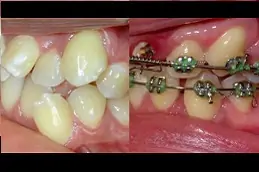What are the Types of Braces?
There are five types of braces available in our clinic, they are:
-
Metal Braces: They assist in rectifying dental & orthodontic issues that are related to the alignment of teeth, issues in biting, and the development of the jaw.
-
Ceramic Braces: These braces are made to move the teeth into the correct position while blending in with the natural colour of the teeth.
-
Self-ligating braces: These braces have a built-in mechanism to hold the arch-wire in place while eliminating the requirement for other ties.
-
Lingual braces: They are customized & designed to be completely hidden from view.
-
Clear aligners like Invisalign: They are made to straighten the teeth without being visible.
Results of Braces in Georgia:
Braces take time to bring the results, but no doubt that the results they take out are outstanding and extraordinary. Well, the best thing is that these results are for a lifetime with no changes in the shape of teeth. Our clients are always satisfied with their appearance, whether kids or adults.
Are you the Right Candidate?
There is a criteria for the candidates who are right for the treatment.
- Good oral health.
- Crooked or misaligned.
- Bite problems such as overbite, underbite, or crossbite.
- Any existing cavities or gum disease must be treated before beginning orthodontic treatment.
- The candidates must be dedicated to the process.
- Children, teenagers, and adults.
Instructions before the Procedure:
Before undergoing Ceramic treatment, the candidates are required to follow a few instructions given by the doctor:
- Avoid eating hard food.
- Refrain from consuming alcohol.
- Do regular brushing and flossing.
- Clean your teeth before the treatment
- Try not to smoke or do not use teeth-staining products.
- If you have any periodontic issues, you should have it done before the dental braces to have a better treatment.
Steps of Procedure:
Step 1: The initial step is to meet the expert on the treatment where the orthodontics will evaluate the teeth and jaw, impressions of the teeth will be taken, and treatment options will be discussed.
Step 2: A customized treatment plan will be made according to the preferences and goals of the candidates.
Step 3: The teeth will be cleaned and prepared for the process of bonding.
Step 4: By using special bonding, the braces are attached to the teeth.
Step 5: Wires are adjusted once the brackets are attached.
Step 6: A retainer will be provided to assist in maintaining the new position, after the removal of braces.
Post-care of the Procedure:
As it is a non-surgical treatment, it doesn’t need much aftercare, but as it is a treatment for dental health, oral care is critical to have better results and health. Some of the main aftercare include:
- Do brush your teeth twice a day to make the braces and teeth clean
- Do floss while brushing to make sure there remains nothing inside the braces
- Use mouthwash as well
- If soreness is felt use warm salt water
- Try to eat soft food for 1 to 2 days
- Avoid eating hard or chewy food
Dental Braces in Georgia (FAQ’s):
How Long Do Braces Take?
Teeth straightening through the use of Dental Braces can be achieved in as little as 6 months but it can take considerably more time for severely crooked teeth. The average time period required for braces ranges from 1.5 years (18 months) to 2 years (24 months).
How Do You Brush With Braces?
You can brush your teeth using a normal toothbrush. The trick is to brush at a 45-degree angle, both above and below the brackets while also considering brushing near the gum line. This will ensure that no food particle remains stuck to your braces or teeth..
Do Braces Weaken Teeth?
No, Dental Braces can change the position of your teeth and you may feel slight discomfort due to the pulling of the brackets on your teeth. However, you will get used to this over time as the teeth become aligned with the brackets.
What Food Can't Be Eaten With Braces?
Although you can eat almost anything with Dental Braces, certain foods that can get stuck in your braces such as popcorn, nuts, chewing gum, and candies should be avoided while you have braces.
What Age Is Best For Braces?
Early ages between 10-14 years are best suited for getting Dental Braces as during this time the body is developing and it's easier to align teeth using braces as the bone is softer. The teeth have not yet settled in their post-puberty positions.
Why Does My Smile Look Weird After Braces?
It's normal to notice changes in your smile as the braces may give a protruding look. Using Invisalign can resolve this issue partially as they are thinner and can blend in more easily. In the long run, braces can greatly improve your smile once they are taken off.
Is Tooth Removal Necessary For Braces?
No, getting a tooth extracted for braces is rare and is usually only done in case of crowded teeth. Consult your dentist to evaluate your particular case as different treatment is needed for different cases.
Benefits:
This procedure is a set of benefits. It brings a lot of benefits besides making them straight. Some of its main benefits include:
- It decreases the risk of tooth decay or other diseases regarding gums
- It mends the structure of teeth, which mends the bite
- It helps improve crossbite, overbite, underbite, and open bite
- Closes the gaps between teeth
- Helps in aligning misaligned teeth
- Correct the issue of crowding teeth
- Match the midlines
- This procedure also treats TMJ
- Boost your confidence
Get the Appealing Smile and Lifetime Happiness!
Get a consultation for this treatment right away with us at Sydney Royal Clinic. All you have to do is fill out the form mentioned below to let our team get back to your queries.





